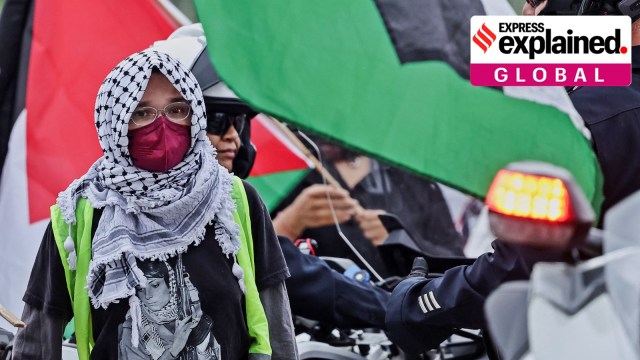Renowned Indian-American author Jhumpa Lahiri declined an award from New York City’s Noguchi Museum after it fired three employees for wearing keffiyeh scarves — a garment long associated with Palestinian solidarity.
“Jhumpa Lahiri has chosen to withdraw her acceptance of the 2024 Isamu Noguchi Award in response to our updated dress code policy,” according to an email statement from the museum on Wednesday (September 25), cited by The New York Times.

The NYT reported that in August, the museum announced a policy banning employees from wearing clothing or accessories that expressed “political messages, slogans or symbols.” What is the keffiyeh and how did it become linked to the Palestinian cause?
History of the keffiyeh
The keffiyeh is one of the many scarves worn in the Middle East. Usually made of cotton (or its blend) and white in colour, it features some patterns. According to an Al Jazeera report, elements of the local culture are reflected in the designs. A net-like pattern resembles fishing nets, with fishing historically being a major occupation in the region. It also has patterns depicting the leaves of the olive trees found here.
Armin Langer, an Assistant Professor of European Studies at the University of Florida, traced the centuries-old history of the garment in an article for The Conversation. Initially, it had utility as a head covering in the harsh desert sun. In particular, it was used by people from the lower classes.
In the book Fashion and Politics, author Djurdja Bartlett wrote, “It was headwear that marked men as city dwellers, villagers, or Bedouin (a nomadic group), and indicated their religious affiliation and socio-economic position…. The keffiyeh was a marker of low status, distinguishing the fellah—peasant—from the effendi—the educated middle-class men of the town, who wore the maroon-coloured tarbush or fez.”
In addition to becoming a popular working-class garment, the keffiyeh gradually became a symbol of nationhood for the Palestinians.
Story continues below this ad
How keffiyeh became a Palestinian symbol
The British gained control of Palestine in 1917 after the fall of the Ottoman Empire. Opposition to British rule led to the keffiyeh’s use for depicting national unity in the 1930s. “Some rebels strategically donned the keffiyeh to hide their faces, as a way to avoid potential repercussions from British authorities,” Langer wrote.
A 2015 report from AFP quoted Abdelaziz al-Karaki, who had worked for a Palestinian keffiyeh-making factory for more than four decades, as saying, “They (the British) said that anyone who wore the Bedouin scarf was an opponent and suddenly everyone started wearing them.”
In 1948, following the creation of Israel and the subsequent Arab-Israeli war, more than 750,000 Palestinians were displaced from their homes. Langer wrote, “The keffiyeh became an expression of Palestinian resilience against Israel’s treatment of Palestinians. Worn by both those who were displaced and those who remained, the headdress captured the emotional connection to the land.”
Palestine Liberation Organisation leader Yasser Arafat also popularised the scarf in the 1970s. South African leader Nelson Mandela also wore the keffiyeh in solidarity. In 1994, three years after apartheid ended, Mandela said, “We know too well that our freedom is incomplete without the freedom of the Palestinians.”
Story continues below this ad
 Yasser Arafat with Israeli PM Ehud Barak and US President Bill Clinton at Camp David Summit, 2000. (Via Wikimedia Commons)
Yasser Arafat with Israeli PM Ehud Barak and US President Bill Clinton at Camp David Summit, 2000. (Via Wikimedia Commons)
Why keffiyehs have been banned at times
In the West, wearing the keffiyeh has been seen as registering opposition to Israel. As a result, the scarf has been banned at times, including after October 7, 2023.
Following the Hamas attack on Israel that led to around 1,200 killings, the ongoing Israeli military offensive on the Gaza Strip has led to the killings of more than 40,000 people. The protests against Israeli action have seen people wear the scarf.
The legislature of Canada’s Ontario province allowed politicians and staff to wear keffiyehs in the building, but banned them from doing so inside the legislative chamber, according to a CBC report.
The legislature of the Australian province of Victoria similarly banned the scarf in the chamber. Shaun Leane, President of the upper house, said it could be termed “symbolism” that the whole chamber was not reasonably expected to get behind.
Story continues below this ad
Leane also told a Member of Parliament that watermelon earrings could not be worn. The fruit has been used as another Palestinian symbol as it matches the colours of the Palestinian flag, which has been restricted in public by Israeli authorities at times. Notably, the keffiyeh has also been used as a flag at protests.
In the late 2000s, fashion brands like the US-based Urban Outfitters and the UK’s TopShop began selling keffiyeh-like designs. Palestinians criticised this as sellers profiting off their culture without giving due recognition to their history. The garment becoming a fashion trend also resulted in cheap and China-made replicas entering the market.



 Yasser Arafat with Israeli PM Ehud Barak and US President Bill Clinton at Camp David Summit, 2000. (Via Wikimedia Commons)
Yasser Arafat with Israeli PM Ehud Barak and US President Bill Clinton at Camp David Summit, 2000. (Via Wikimedia Commons)



































